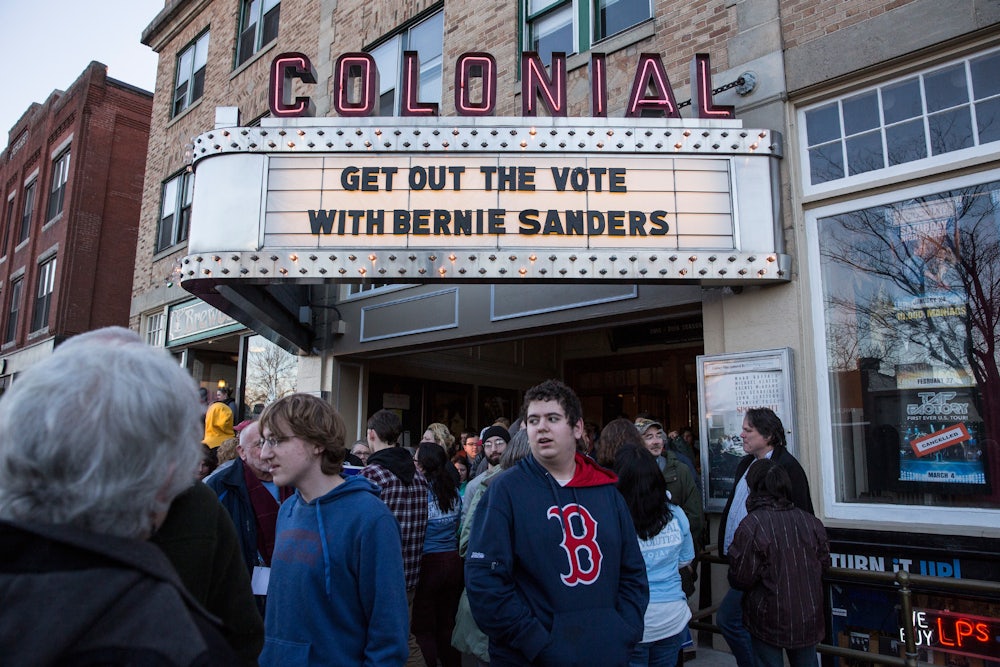On Monday night, Senator Bernie Sanders of Vermont tested out his “radical idea”—a vision of American democratic socialism—with real American voters in Iowa. Numerically, the race was a dead heat, with Clinton barely inching ahead of Sanders. It was not, in other words, the kind of explosive surge that might produce its own groundswell of enthusiasm, a victory begetting more victories. But for a candidate who had been expected to be a non-threatening bit-player in the Democratic primary, the achievement was enormous. And for Americans hoping to see a way forward for democratic socialism on their home turf, it was even bigger.
“I think it’s overwhelmingly positive,” David Duhalde, deputy director of Democratic Socialists of America, told the New Republic of Sanders’s performance. “People were pleasantly surprised at how well Bernie did. I think just the tie is a victory in itself, and it just shows how much he overcame with pretty much just volunteers, a handful of union endorsements, and a really, really good message that really resonated with people.”
Democratic Socialists of America is the largest socialist organization in the United States, and has been pushing to “establish an openly democratic socialist presence in American communities and politics” since 1982. But Americans who identify with the broad category of socialism have faced an uphill battle over the last several decades. Since the Cold War, socialism has been a dirty word in American politics, used more often to smear public figures like Barack Obama and Pope Francis than to identify a real set of political values and programs. A 2015 Gallup poll found that 50 percent of Americans would have a hard time voting for a self-proclaimed socialist presidential candidate, the highest rate of disapproval in a slate of hypothetical candidate identities that included Jewish, gay or lesbian, a woman, black, and atheist.
But Sanders’s candidacy has shifted the public perception of socialism—at least notional socialism—somewhat. “He’s made it easier to identify as a socialist, and for people to organize as socialists,” Duhalde said. “Our new membership rates have doubled since he’s been running. So people are willing not just to identify as socialists, but to actually make that financial commitment.”
Part of Sanders’s success campaigning under the socialist banner likely arises from the base he has managed to reach: namely younger, further-left, and lower-income voters. Exit polls from Monday night’s Iowa caucuses found that Sanders won 84 percent of voters between the ages of 17 and 29, 58 percent of voters who identified as “very liberal,” and 57 percent of those making under $30,000 per year. Sanders pulled in half of those making between $30,000 and $49,000 per year, losing his lead over Clinton only as the income bracket shifted upward: Clinton took 55 percent of the $100,000 and over category, with Sanders trailing at 37 percent.
Among voters who felt that income inequality is the most important issue facing the country, Sanders claimed 61 percent of the vote. Sanders also won 59 percent of votes from first-time caucus-goers, likely thanks to a combination of his appeal to young voters and his ability to generate interest in those otherwise indifferent to mainstream politics.
The profile of Sanders supporters, many poorer and younger with a strong interest in reducing inequality, suggests the makings of a coalition that could carry on regardless of the outcome of his particular candidacy. With many years ahead to campaign for Sanders-esque social democratic policies—which are, as author Lane Kenworthy pointed out, nothing more extreme than a smattering of insurance programs run by the government—the newly engaged, personally invested Sanders cohort could easily continue the fight for single-payer healthcare, universal higher education, and more robust state-run family leave programs.
Duhalde said Democratic Socialists of America intends to ride the tailwinds of Sanders’s newfound, newly energized base by continuing to unite the simpler goals of democratic socialism (like the aforementioned insurance programs) with broader egalitarian goals already meaningful to the young and left-leaning. “What’s been really interesting on our end is really seeing that people are interested and excited, and so what DSA is doing is this political revolution tour, where we are hosting events organized around the country by DSA and People for Bernie, so we’re reaching out to DSA folks, and also Sanders volunteers to begin conversations about what happens next. We’re looking to organize with other anti-oppression movements. So the next few years will be make-or-break for a lot of progressive values and policies, regardless of who’s in office.”
“DSA definitely wants to be part of something bigger than itself,” Duhalde added, “And I think that’s much more possible than a few years ago.” If nothing else, Sanders’s boost to American democratic socialism appears primed to help integrate a set of left-invested voters into the broader liberal coalition, which in turn will help nudge the Democratic Party leftward. If the base Sanders has built proves durable, there may yet be a bright future for social democracy in the United States.
